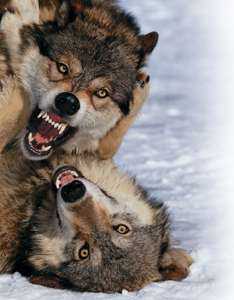Density-Dependent Limiting Factors
 What limiting factors depend on population density?
What limiting factors depend on population density?
Density-dependent limiting factors operate strongly only when population density—the number of organisms per unit area—reaches a certain level. These factors do not affect small, scattered populations as much.  Density-dependent limiting factors include competition, predation, herbivory, parasitism, disease, and stress from overcrowding.
Density-dependent limiting factors include competition, predation, herbivory, parasitism, disease, and stress from overcrowding.

FIGURE 5–7 Competition Male wolves may fight one another for territory or access to mates.
Competition When populations become crowded, individuals compete for food, water, space, sunlight, and other essentials. Some individuals obtain enough to survive and reproduce. Others may obtain just enough to live but not enough to enable them to raise offspring. Still others may starve to death or die from lack of shelter. Thus, competition can lower birthrates, increase death rates, or both.
Competition is a density-dependent limiting factor, because the more individuals living in an area, the sooner they use up the available resources. Often, space and food are related to one another. Many grazing animals compete for territories in which to breed and raise offspring. Individuals that do not succeed in establishing a territory find no mates and cannot breed.
Competition can also occur among members of different species that are attempting to use similar or overlapping resources. This type of competition is a major force behind evolutionary change.
Predation and Herbivory The effects of predators on prey and the effects of herbivores on plants are two very important density-dependent population controls. One classic study focuses on the relationship between wolves, moose, and plants on Isle Royale, an island in Lake Superior. The graph in Figure 5–8 shows that populations of wolves and moose have fluctuated over the years. What drives these changes in population size?
▸ Predator-Prey Relationships In a predator-prey relationship, populations of predators and prey may cycle up and down over time. Sometimes, the moose population on Isle Royale grows large enough that moose become easy prey for wolves. When wolves have plenty to eat, their population grows. As the wolf population grows, the wolves begin to kill more moose than are born. This causes the moose death rate to rise higher than its birthrate, so the moose population falls. As the moose population drops, wolves begin to starve. Starvation raises the wolves' death rate and lowers their birthrate, so the wolf population also falls. When only a few predators are left, the moose death rate drops, and the cycle repeats.
 In Your Notebook Describe conditions that lead to competition in a population.
In Your Notebook Describe conditions that lead to competition in a population.

Quick Lab
GUIDED INQUIRY
How Does Competition Affect Growth?
Label two paper cups 3 and 15. Make several small holes in the bottom of each cup. Fill each cup two-thirds full with potting soil. Plant 3 bean seeds in cup 3, and plant 15 bean seeds in cup 15.
-
Water both cups so that the soil is moist but not wet. Put them in a location that receives bright indirect light. Water the cups equally as needed.
-
Count the seedlings every other day for two weeks.
Observe What differences did you observe between the two cups?
Analyze and Conclude
Table of Contents
- Formulas and Equations
- Applying Formulas and Equations
- Mean, Median, and Mode
- Estimation
- Using Measurements in Calculations
- Effects of Measurement Errors
- Accuracy
- Precision
- Comparing Accuracy and Precision
- Significant Figures
- Calculating With Significant Figures
- Scientific Notation
- Calculating With Scientific Notation
- Dimensional Analysis
- Applying Dimensional Analysis




